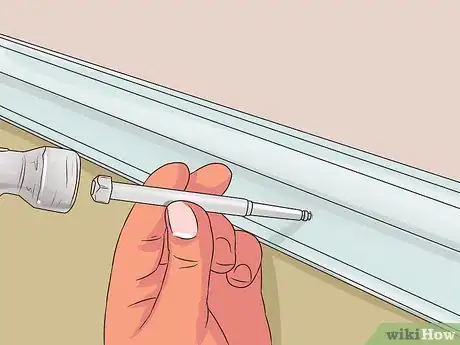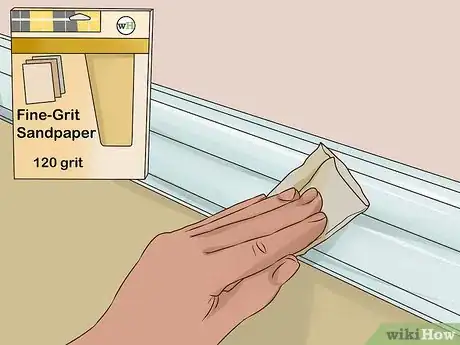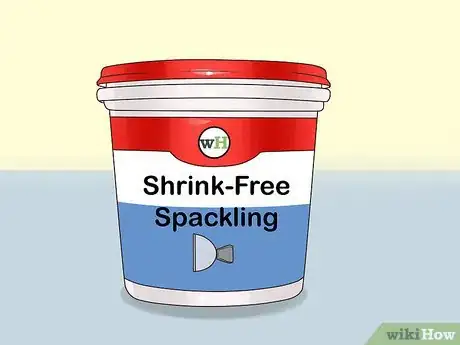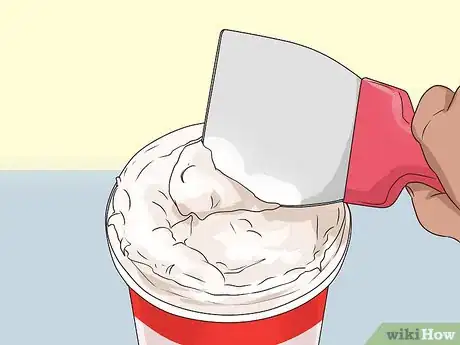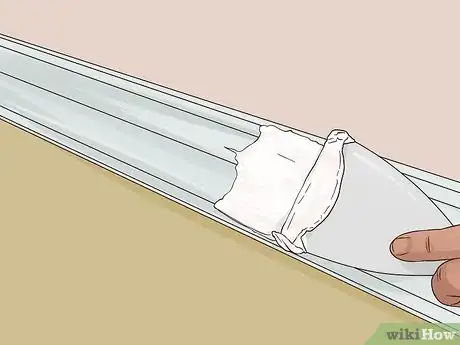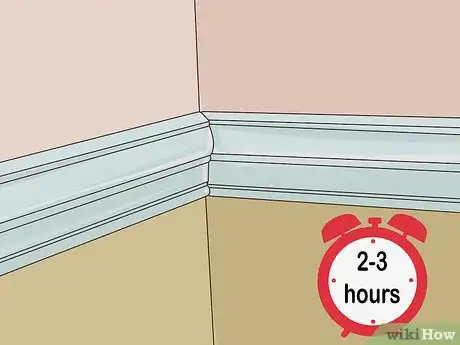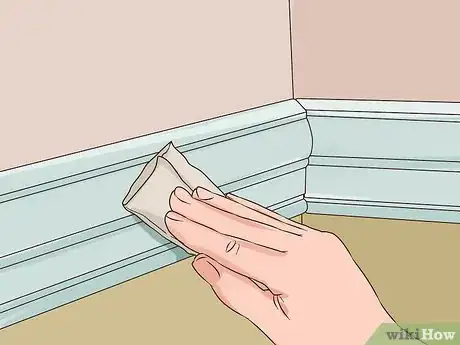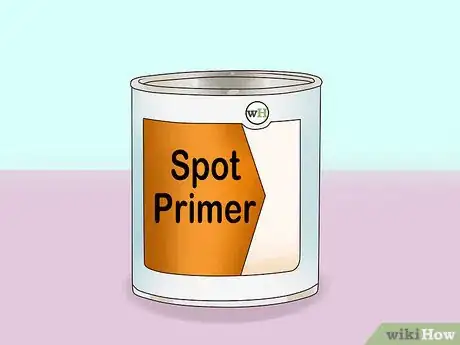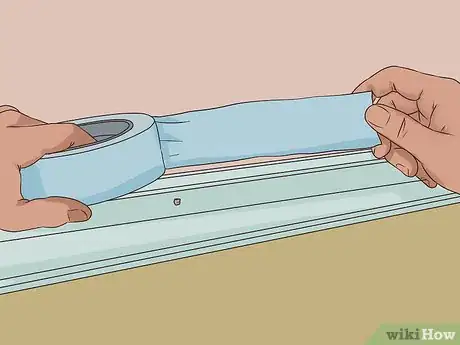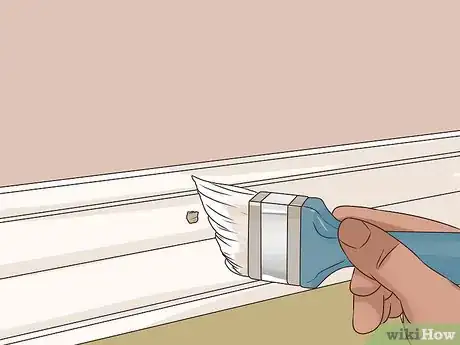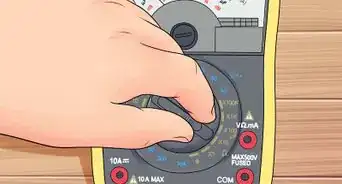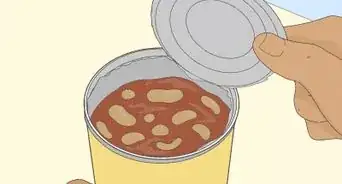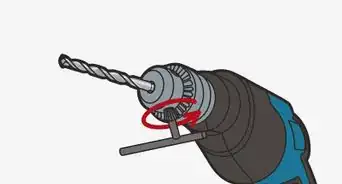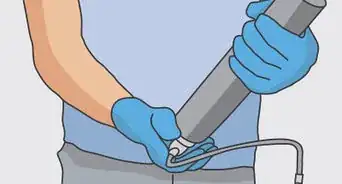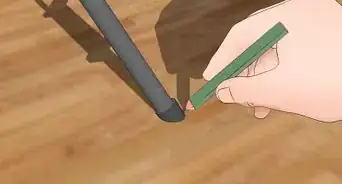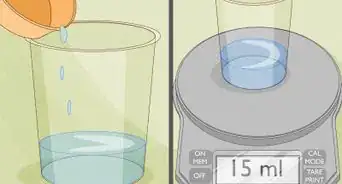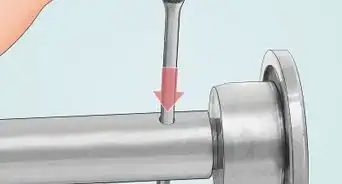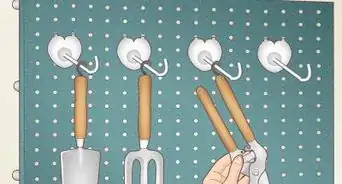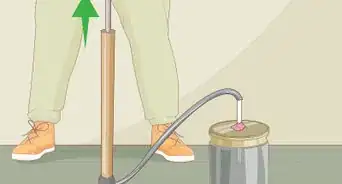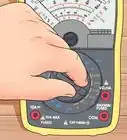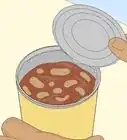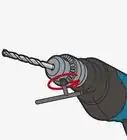This article was co-authored by Art Fricke and by wikiHow staff writer, Kyle Hall. Art Fricke is a home renovation and repair specialist and the owner of Art Tile & Renovation based in Austin, Texas. With over 10 years of experience, he specializes in bathroom and kitchen renovations. Art focuses on a single contractor approach to customized renovation work, and performs projects such as installing custom tile showers, fixing tiled shower leaks, replacing cracked tiles, and installing floor and wall tile.
wikiHow marks an article as reader-approved once it receives enough positive feedback. In this case, 100% of readers who voted found the article helpful, earning it our reader-approved status.
This article has been viewed 101,374 times.
Nail holes can ruin the appearance of trim on a wall. Fortunately, filling in nail holes in trim is a simple process. Before you fill in the holes, you’ll need to go over them with a putty knife and sandpaper to make sure they’re smooth. Then you can fill them in with spackling and paint over them. If you use the right tools and supplies, you'll have brand-new looking trim that's free of unsightly nail holes.
Steps
Smoothing Over the Nail Holes
-
1Hammer in any nails that are protruding from the trim with a nail set. You can find a nail set at your local hardware store if you don’t have one. Hold the pointed end of the nail set on the head of the nail. Hammer the nail set so the nail goes into the trim. If the trim is held on with staples, use a flat-head screwdriver approximately the same size as the staples to tap them into the trim.[1]
- Use a putty knife or painter’s 5-in-1 tool to pry up any staples or nails that are bent into the wood. Then, use needle-nose pliers to remove the staple or nail from the trim.
-
2Use a putty knife to scrape off any raised fragments around the holes. Sometimes nail holes in trim can form a raised edge. It’s important to get rid of these edges on the trim or they’ll show after you fill the holes. Scrape the putty knife across the surface of the nail hole a few times to smooth out the area around the hole.[2]
- Be gentle when you’re using the putty knife. You don’t want to cause damage to the trim around the nail holes.
- If the trim has ridges or raised edges, use a butter knife to remove the fragments so you don’t damage the details.
Advertisement -
3Smooth down the nail holes with fine-grit sandpaper. Any sandpaper with a grade between 120 and 220 will work. The sandpaper should be able to get off any raised fragments on the trim that the putty knife couldn’t. Brush the sandpaper across the surface of the nail holes a few times until they feel smooth.[3]
Applying the Spackling
-
1Get shrink-free spackling. Shrink-free spackling won’t shrink when it dries in the holes on the trim. Avoid spackling that shrinks or you could end up with dips in the holes you fill in. You can find shrink-free spackling online or at your local hardware store.[4]
- You can use water-based wood filler or even painter's caulk as alternatives. The wood filler can be sanded down smooth, and you can paint over it for a seamless finish. The caulk will be more noticeable, however.
-
2Scoop out some spackling from the container with a putty knife. You don’t need a lot. You just want enough on the knife to fill in a nail hole. Scoop out the spackle with the end of the knife so it’s easier to press into a hole.[5]
-
3Press the spackling on the knife into one of the nail holes. Start with the edge of the knife on one side of the hole at a 45-degree angle. Scrape the knife across the surface of the hole to the other side. Press firmly down on the knife so the spackling completely fills in the nail hole. Scrape across the surface of the hole two or three times to make sure the spackling is flat. [6]
- To smooth out the spackling and/or fill the holes, you can also use your finger.
-
4Use a damp cloth to wipe away any excess spackling around the hole. Do this immediately after you spackle all the holes in the trim so the spackling doesn’t have time to dry.[7]
-
5Let the spackling dry for 2-3 hours. Check back on the spackling after a few hours to see if it’s dry. If it’s not, let it continue drying. If you notice a dip in the spackling inside the nail hole, apply another coat and wait 2-3 more hours for the new coat of spackling to dry.[8]
-
6Sand off excess spackling with a fine-grit sandpaper. Lightly brush the sandpaper across the surface of the trim where the hole is until the spackling is flush with the trim. [9]
Painting Over the Holes
-
1Wipe down and vacuum the trim so there’s no leftover dust. Any dust particles left on the trim may be visible after you finish painting. Use a paintbrush or cloth to wipe down the surface of the trim, and attach a brush head to the vacuum for the best results.[10]
-
2Apply a spot primer over the spackled nail holes. Spot primer will prevent the spackling spots on the trim from looking different from the rest of the trim when they get painted over. Use a paintbrush to apply a thin coat of spot primer over each filled-in nail hole. You can find spot primer at your local hardware store.[11]
-
3Put painter’s tape on any surfaces you don’t want paint to get on. Cover the parts of the walls directly around the trim. Apply a strip of painter’s tape to the floor if you’re painting a baseboard.[12]
-
4Paint the trim using a paintbrush. Use the same paint that was used on the rest of the trim. You may need to do multiple coats before the paint looks even on the trim. If you sanded down the filled nail holes and primed them with a spot primer, they should be completely hidden behind the fresh paint.[13]
Expert Q&A
Did you know you can get expert answers for this article?
Unlock expert answers by supporting wikiHow
-
QuestionWhat do you use to fill nail holes in trim?
 Art FrickeArt Fricke is a home renovation and repair specialist and the owner of Art Tile & Renovation based in Austin, Texas. With over 10 years of experience, he specializes in bathroom and kitchen renovations. Art focuses on a single contractor approach to customized renovation work, and performs projects such as installing custom tile showers, fixing tiled shower leaks, replacing cracked tiles, and installing floor and wall tile.
Art FrickeArt Fricke is a home renovation and repair specialist and the owner of Art Tile & Renovation based in Austin, Texas. With over 10 years of experience, he specializes in bathroom and kitchen renovations. Art focuses on a single contractor approach to customized renovation work, and performs projects such as installing custom tile showers, fixing tiled shower leaks, replacing cracked tiles, and installing floor and wall tile.
Home Renovation & Repair Specialist
Things You’ll Need
- Hammer
- Nail set
- Putty knife
- Fine-grit sandpaper
- Shrink-free spackling, painter’s caulk, or water-based wood filler
- Cloth
- Vacuum
- Spot primer
- Painter’s tape
- Paint
- Paint brush
- 5-in-1 painter’s tool (optional)
- Needle-nose pliers (optional)
- Flat-head screwdriver (optional)
- Butter knife (optional)
References
- ↑ https://projects.truevalue.com/paint/interior/prep_cleanup_and_safety/proper_spackling_techniques.aspx
- ↑ https://projects.truevalue.com/paint/interior/prep_cleanup_and_safety/proper_spackling_techniques.aspx
- ↑ https://projects.truevalue.com/paint/interior/prep_cleanup_and_safety/proper_spackling_techniques.aspx
- ↑ https://www.youtube.com/watch?v=jd1tyDuewPo&feature=youtu.be&t=56
- ↑ https://www.youtube.com/watch?v=jd1tyDuewPo&feature=youtu.be&t=102
- ↑ https://www.youtube.com/watch?v=jd1tyDuewPo&feature=youtu.be&t=105
- ↑ https://projects.truevalue.com/paint/interior/prep_cleanup_and_safety/proper_spackling_techniques.aspx
- ↑ https://projects.truevalue.com/paint/interior/prep_cleanup_and_safety/proper_spackling_techniques.aspx
- ↑ https://projects.truevalue.com/paint/interior/prep_cleanup_and_safety/proper_spackling_techniques.aspx
- ↑ https://www.familyhandyman.com/painting/tips/trim-painting-tips-for-smooth-and-perfect-results/view-all/
- ↑ https://www.familyhandyman.com/painting/tips/trim-painting-tips-for-smooth-and-perfect-results/view-all/
- ↑ https://www.familyhandyman.com/painting/tips/trim-painting-tips-for-smooth-and-perfect-results/view-all/
- ↑ https://www.familyhandyman.com/painting/tips/trim-painting-tips-for-smooth-and-perfect-results/view-all/
About This Article
Nail holes can ruin the appearance of trim on a wall, but fortunately filling these tiny holes in is a simple process. Before you fill in the holes, use a putty knife to scrape off any raised fragments around them. You can also smooth over these holes with a fine-grit sandpaper, which should be able to get rid of any raised fragments on the trim that the putty knife couldn’t get. Then put some shrink-free spackling on a knife and scrape it across the surface of the hole. Right after you spackle the holes, use a damp cloth to wipe away any excess around the hole. Let the spackling dry for 2 to 3 hours, then apply a second coat or sand off any excess with a fine-grit sandpaper. Finally, paint over the holes by applying a spot primer and the same paint that was used on the rest of the trim. To learn how to hammer in any nails that are protruding from your trim, keep reading!
